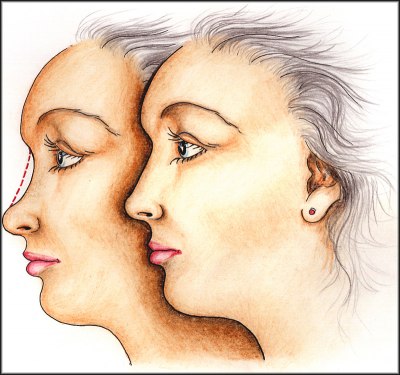Nose Job - Nose Surgery
(Rhinoplasty)The aim in nose correction is to solve congenital and traumatic deformations of the nose, or just to make the shape of your nose you would like to have.
Nose surgery - rhinoplasty -is one of the most exacting operations done by the aesthetic surgery. The nose, being the focus of the face, is very sensitive in perception by the patients and the others and its reshaping, reduction or increase in size frequently changes the general expression of the face and thus of the personality. The surgery may also repair and improve problems in nasal function, i.e. breathing and its effects in aesthetic,

function and psychology are considerable because it will free the patient of the complexes and enhance his/her physical and spiritual harmony. The initial and a very important step to be taken before any decision on the surgery is made is a personal consultation with an experienced plastic surgeon. Any problems related to the nose shape, size and type, breathing and particularly motives or psychological reasons that brought the patient to the surgery should be evaluated. The surgeon's approach to each patient is most individual because any rhinoplasty is individual and specific. The state of good health is a natural prerequisite. The optimum age range for rhinoplasty, is from the completion of growth and end of adolescence (girls circa 16 -17 years of age, boys from the age of 18) to approximately 30 years of age. It is not only the aspect of healing -sufficient elasticity and adaptability of tissues -but also the psychological aspect -easier taking up a position in a circle of friends and personality formation with younger patients after the surgery.

The operation is only the first stage the surgeon is able to influence directly. The essential prerequisite for success is the impeccable technique of the surgery. The second stage is the healing process. The surgeon may produce an indirect effect on it through his/her instruction and advice. The patient's collaboration is very important. The postoperative stage of healing is a long process and its progress is very individual. It's impossible to evaluate the result before 2 or 3 months elapse and the complete stabilisation may take as much as one full year. Even after a perfectly done surgery and good postoperative collaboration with the patient, the process of healing and scarring the soft nose tissues may produce unfavourable effects on the resulting shape and the required effect. Yet complications are not frequent and may be resolved by corrective surgery after the tissues are stabilised.

Surgery and Postoperative Period
The surgery is usually done under general anaesthesia. The surgery is done by an internal method -through the nostrils. In result, there are no external scars. During the surgery, the soft parts, cartilage and nasal bones are loosened and reshaped.
The surgery is completed by adhesive plaster and plaster fixation of the nose and a nasal tampon. Temporary eyelid swelling and bruising is a part of the postoperative course. The nose is packed with tampons and the patient must breath through the mouth. The mouth mucosa gets dry more quickly and therefore it is necessary to drink more frequently, with cold compresses being applied over the eyes to reduce swelling. Rest is recommended for three to four days after the surgery. For several days following the surgery, the patient should make provisions to enable him/her to report for a check-up at this department within the shortest possible time or to contact the physician on the phone when any subjective troubles or complications arise. The tampons have to be removed on day 3 -4 from the surgery and then it is possible to breathe through the nose. The nose should be kept clean using cotton brushes every 2 -3 hours. The patient must not blow his/her nose. On day 7 -10 after the surgery, the suture is removed and the plaster splint is checked. On day 17 -21, the plaster splint is removed and will be applied at night only for another 10 -14 days. The dates of following appointments should be made by the doctor and used to explain postoperative care or to recommend

compressive massages when required that are essential for the healing process and the resulting effect. The nose may be considered stabilised in shape and function about three months after surgery. It's necessary however to expect mild swelling and reddening of the nose at sudden temperature changes to continue for several months. The patients may get back to a normal life pace after the plaster is removed. Women may resume the use of usual cosmetic preparations, including makeup. Every patient may resume sports and full physical load after 6 -8 weeks. The data presented is based on a common post-operation course. However, a recovery is an individual process depending not only on healing abilities of every individual body, but also on every patient's conscientiousness. The patient is expected to set such conditions for a period of several days after her operation to be able, in case of any subjective problems or complication, to come as soon as possible for examination to our department. A positive operation result and mutual satisfaction is in your interest as well as in ours. Mutual trust and co-operation of the patient with the surgeon is a vital precondition.








